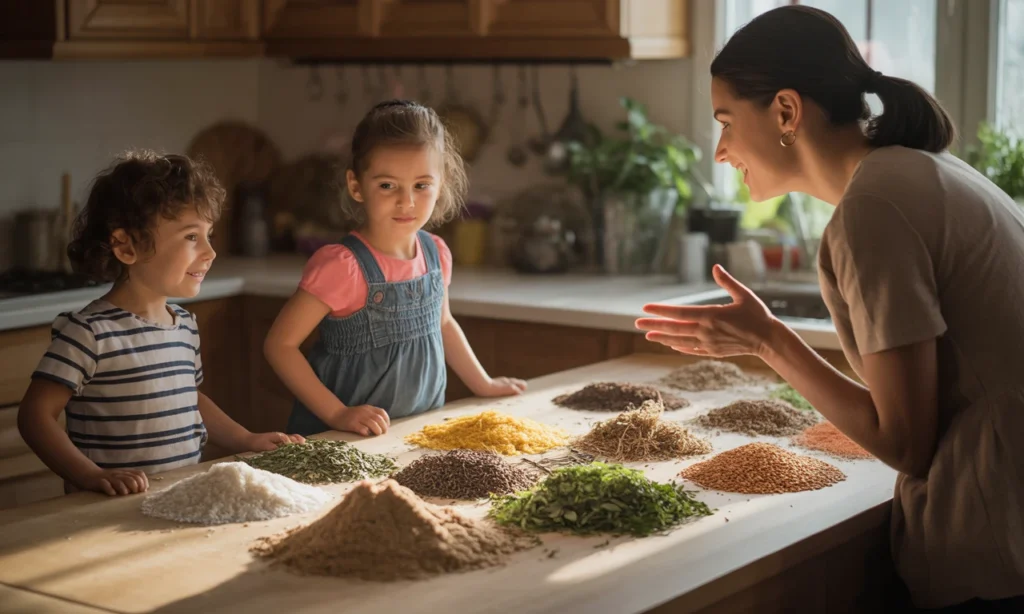Last Updated on October 13, 2025 by XAM CONTENT
New book for CBSE Class 6 Curiosity, Textbook of Science for Grade 6 learners has been published by NCERT as per National Education
Policy (NEP) 2020. Curiosity, Textbook of Science for Grade 6, comprises twelve chapters. Through the chapters, learners will embark on a journey that will connect them to the world around and spark curiosity for further exploration.
We are providing case study questions for class 6 science. Case study questions are the new question format that is introduced in CBSE board. The resources for case study questions are very less. So, to help students we have created chapterwise case study questions for class 6 science. In this article, you will find case study questions for cbse class 6 science chapter 9 Methods of Separation in Everyday Life.
| Chapter | Methods of Separation in Everyday Life |
| Textbook Name | Curiosity |
| Publication Date | July 2024 |
| Type of Questions | Case Study Questions |
| Nature of Questions | Competency Based Questions |
| Board | CBSE |
| Class | 6 |
| Subject | Science |
| Useful for | Class 6 Studying Students |
| Answers provided | Yes |
| Difficulty level | Mentioned |
| Important Link | Class 6 Science Chapterwise Case Study |
Case Study Questions on Methods of Separation in Everyday Life
Questions
Passage 1:
Read the given passage below and answer the questions:
Jinni and Jonny were naughty kids. One evening, they were playing at home with different materials present in the home instead of their toys. They mixed so many things together. For example, they mixed rice with lentils, sand with sawdust, soil with water, and iron pins with tea leaves. Their elder sister Rita came and looked at the mess they had created. She started scolding them. But then their mummy came and said we can clear this mess. There are many different methods to separate mixtures such as hand-picking, winnowing, sieving, magnetic separation, sedimentation and decantation, filtration, dissolution and evaporation. With the help of these methods, she separated all the mixtures and put those things back in place.

Q. 1. Dissolving a solid, liquid or gas in a liquid is called __________.(a) mixture
(c) sedimentation
(b) dissolution
(d) decantation
Difficulty Level: Difficult
Ans. Option (b) is correct.
Explanation: Dissolving a solid, liquid or gas in a liquid is called dissolution. This method is useful when one constituent of a solid mixture is soluble in a solvent and the other is not.
Q. 2. Which of the following methods will be used to separate sand from sawdust?
(a) Filtration
(c) Winnowing
(b) Hand-picking
(d) Evaporation
Difficulty Level: Medium
Ans. Option (c) is correct.
Explanation: The winnowing method is used when one constituent is lighter than the other one. Farmers use this method to separate chaff (the covering of grain) from the grain. A mixture of chaff and grain is made to fall from a height. The lighter chaff drifts away, and the heavier grain falls vertically on the ground.
Q. 3. Consider the following statements about filtration:
(i) Used to separate solid-solid mixture.
(ii) Uses filter paper.
(iii) Solids collect on filter paper
(iv) Filter paper absorbs all liquid.
The correct statements are:
(a) (i) and (ii)
(b) (ii) and (iii)
(c) (iii) and (iv)
(d) (i), (ii) and (iv)
Difficulty Level: Medium
Ans. Option (b) is correct.
Explanation: Filtration is used to separate an insoluble solid from its liquid mixture. In the filtration method, the funnel is fitted to a stand and a beaker is placed below in such a way that the stem of the funnel doesn’t touch the wall of the beaker. A filter paper is placed on the funnel. The mixture or suspended liquid is slowly poured into the funnel. The solid collects on the filter paper, whereas the liquid passes through.
Passage 5:
Filtering Tea and Coffee
Valli made tea for her grandmother and poured it through a fine cloth. The tea leaves stayed on the cloth and the liquid tea passed through. Her grandmother explained this is filtration, commonly used at home.
Q1. What does filtration separate?
(a) Solids from solids
(b) Liquids from liquids
(c) Solids from liquids
(d) Gases from air
Difficulty Level: Easy
Answer: (c) Solids from liquids
Q2. In tea making, what is the residue?
(a) Sugar
(b) Tea leaves
(c) Milk
(d) Water
Difficulty Level: Easy
Answer: (b) Tea leaves
Q3. What do we call the liquid that passes through in filtration?
(a) Sediment
(b) Mixture
(c) Filtrate
(d) Evaporate
Difficulty Level: Medium
Answer: (c) Filtrate
Q4. What is used as a filter in this process?
(a) Knife
(b) Cloth or sieve
(c) Stone
(d) Metal plate
Difficulty Level: Easy
Answer: (b) Cloth or sieve
Also check:
- Beyond Earth Class 6 Case Study Questions Science Curiosity Chapter 12
- Nature’s Treasures Class 6 Case Study Questions Science Curiosity Chapter 11
- Living Creatures Class 6 Case Study Questions Science Curiosity Chapter 10
- Methods of Separation in Everyday Life Class 6 Case Study Questions Science Curiosity Chapter 9
- A Journey Through States of Water Class 6 Case Study Questions Science Curiosity Chapter 8
- Temperature and Its Measurement Class 6 Case Study Questions Science Curiosity Chapter 7
- Materials Around Us Class 6 Case Study Questions Science Curiosity Chapter 6
- Measurement of Length and Motion Class 6 Case Study Questions Science Curiosity Chapter 5
- Exploring Magnets Class 6 Case Study Questions Science Curiosity Chapter 4
- Mindful Eating Class 6 Case Study Questions Science Curiosity Chapter 3
- Diversity in the Living World Class 6 Case Study Questions Science Curiosity Chapter 2
- The Wonderful World of Science Class 6 Case Study Questions Science Curiosity Chapter 1
🚀 Boost Your Exam Prep: Get case study questions for all subjects (Class 6-12) now!
👉 Explore more resources on CBSE Class 6
You may also like
Learning Objectives
- To describe different methods of separating mixtures used in everyday life.
- To understand the principles behind these separation techniques like handpicking, sieving and filtration.
- To apply separation methods, such as extracting salt from seawater or removing impurities from food.
- To evaluate advantages and limitations of each separation method in various contexts.
Flour can be separated from wheat grains by sieving due to the difference in the size of flour and grain. Wheat grain will not pass through the sieve.
Hand-picking is the best method for separating the vegetables because they are big in size.
Keywords Related to Methods of Separation in Everyday Life
- Hand-picking: A method of separation where particles are manually selected from a mixture based on size, shape or colour, often used for removing small impurities from food grains
- Threshing: The process of separating grains from the stalks of crops by beating or striking, commonly used in agriculture to harvest cereals
- Winnowing: A technique that uses wind or air to separate lighter components, such as husk, from heavier components, such as grains, typically using a bamboo tray or similar tool
- Sieving: A method where a sieve with varying hole sizes is used to separate particles of different sizes, allowing fine particles to pass through while retaining larger ones
- Filtration: A separation process where a filter paper or other porous material is used to separate solid particles from a liquid, allowing the liquid to pass through while trapping the solids.
🔗👉 Read Also: NCERT Solutions for Class 1 to 12

Frequently Asked Questions (FAQs) on Methods of Separation in Everyday Life Case Study Questions
Q1: What is the new Science textbook “Curiosity” for Grade 6 about?
A1: he new textbook “Curiosity” for Grade 6 Science introduces students to the world of scientific exploration and discovery. It focuses on fostering curiosity and encouraging students to ask questions, observe the world around them, and engage in hands-on activities to understand scientific concepts.
Q2: How is the “Curiosity” textbook different from previous Science textbooks?
A2: “Curiosity” is designed to be more engaging and interactive than previous Science textbooks. It emphasizes inquiry-based learning, where students are encouraged to explore and discover through experiments, observations, and critical thinking rather than just memorizing facts. The textbook is structured around real-world phenomena and everyday experiences to make learning more relevant and exciting for students.
Q3: What are the key themes covered in the “Curiosity” textbook?
A3: The “Curiosity” textbook covers a wide range of themes, including the natural world, physical processes, and basic principles of life sciences. It explores topics such as the properties of materials, the functioning of living organisms, energy, forces, and environmental studies, all while emphasizing the importance of curiosity and inquiry in the learning process.
Q4: How does “Curiosity” support the development of scientific thinking in students?
A4: “Curiosity” supports the development of scientific thinking by encouraging students to ask questions, make observations, conduct experiments, and analyze their findings. The textbook includes activities and projects that help students apply the scientific method, fostering critical thinking, problem-solving, and a deeper understanding of scientific concepts.
Q5: How does “Curiosity” prepare students for higher grades in Science?
A5: “Curiosity” lays a strong foundation for higher grades by introducing students to key scientific concepts and developing their inquiry-based learning skills. By fostering curiosity, critical thinking, and problem-solving abilities, the textbook prepares students for more advanced scientific studies in the middle and high school levels.
Q6: What are heterogeneous mixtures?
A6: Heterogeneous mixtures are mixtures that do not have a uniform appearance and composition throughout.
Q7: Which is the best method to separate rice from rice husk?
A7: Winnowing is the best method to separate rice from rice husk.
Q8: Why is the piece of cloth not used as filter paper for the purpose of filtration?
A8: A piece of cloth is not used as filter paper for the purpose of filtration because filter paper has fine pores, while cloth has larger holes than filter paper.
Q9: How is the method of churning useful during the preparation of buttermilk?
A9: Churning helps in the separation of water from fat or cream. It is a very useful step in the preparation of buttermilk.
Q10: Are there any online resources or tools available for practicing class 6 science “Materials Around Us” case study questions?
A10: We provide case study questions for CBSE Class 6 Science on our website. Students can visit the website and practice sufficient case study questions and prepare for their exams. If you need more case study questions, then you can visit Physics Gurukul website. they are having a large collection of case study questions for all classes.



